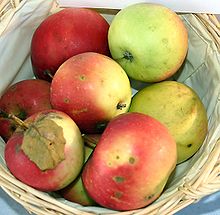| Malus domestica Jonathan | |
|---|---|
 | |
| Species | Malus domestica |
| Cultivar | Jonathan |
| Origin | Woodstock, New York, before 1826 [1] |


Jonathan is a medium-sized sweet [1] apple, with a touch of acid [2] and a tough but smooth skin, good for eating fresh and for cooking. Parentage = Esopus Spitzenburg x ? [3] [2]
| <55 mm | 55-60 mm | 60-65 mm | 65-70 mm | 70-75 mm |
|---|---|---|---|---|
| 9 % | 17 % | 38 % | 31 % | 5 % |
History
There are two alternative theories about the origin of the Jonathan apple.
The first is that it was grown by Rachel Negus Higley, who gathered seeds from the local cider mill in Connecticut before the family made their journey to the wilds of Ohio in 1796, where she planted them. [6] She continued to carefully cultivate her orchard to maturity and named the resulting variety after a young local boy, Jonathan Lash, who frequented her orchard.[ citation needed]
The other, more accepted, theory is that it originated from an Esopus Spitzenburg seedling in 1826, on the farm of Philip Rick(s) in Woodstock, Ulster County, New York. Although it may have originally been called the "Ricks" apple, it was soon renamed by Judge Jesse Buel, President of Albany Horticultural Society, after Jonathan Zander, who discovered the apple and brought it to Buel's attention. [7] [2]

Descendants
- Akane between Jonathan x Worcester Pearmain
- Querina Florina (scab resistant)
- Idared Jonathan x Wagener
- Jonadel Jonathan x Delicious
- Jonagold— Golden Delicious x Jonathan
- Jonamac—a cross between Jonathan and McIntosh apples
- Karminj de Sonnaville Cox Orange x JOnathan.
- King David a cross between Jonathan and Winesap
- Malling Kent Cox Orange x Jonathan
- Mareda a cross between Jonathan and Northern Spy
- Melrose Jonathan x Delicious
- Rubinstar
- Septer Jonathan x Golden Delicious
- Undine
- Wealthy a cross between Jonathan and Duchess of Oldenburg.
Disease susceptibility
- Scab: high [8]
- Powdery mildew: high
- Cedar apple rust: high
- Fire blight: high
- Apple canker (Neonectrica ditissima): medium
References
- ^ a b "Jonathan", National Fruit Collection UK, archived from the original on 20 November 2015, retrieved 7 November 2015
- ^ a b c Beach, S.A.; Booth, N.O.; Taylor, O.M. (1905). "Jonathan". The apples of New York. Vol. 1. Albany: J. B. Lyon. pp. 172–174 – via Biodiversity Heritage Library.
- ^ Luby, Howard, Tillman, Bedford. HortScience 57(3):472-477. 2022
- ^ a b Silbereisen, Robert; Götz, Gerhard; Hartmann, Walter. Obstsorten Atlas [Fruit Varieties Atlas] (in German). ISBN 978-3-86-820219-9.
- ^ Obst und Garten 10/2000 [Fruit and Garden] (in German)
- ^ Johnson, Mary Coffin (1896). The Higleys and their ancestry. New York: D. Appleton and Company – via Archive.org.
- ^ Routson, Kanin; Nabhan, Gary Paul. "Southwest Regis-Tree of Heirloom Perennial Species and Varieties-Fruit and Nut descriptions" (PDF). Northern Arizona University. Archived from the original (PDF) on 2006-12-22.
- ^ Dr. Stephen Miller of the USDA Fruit Research Lab in Kearneysville, West Virginia.[ full citation needed]